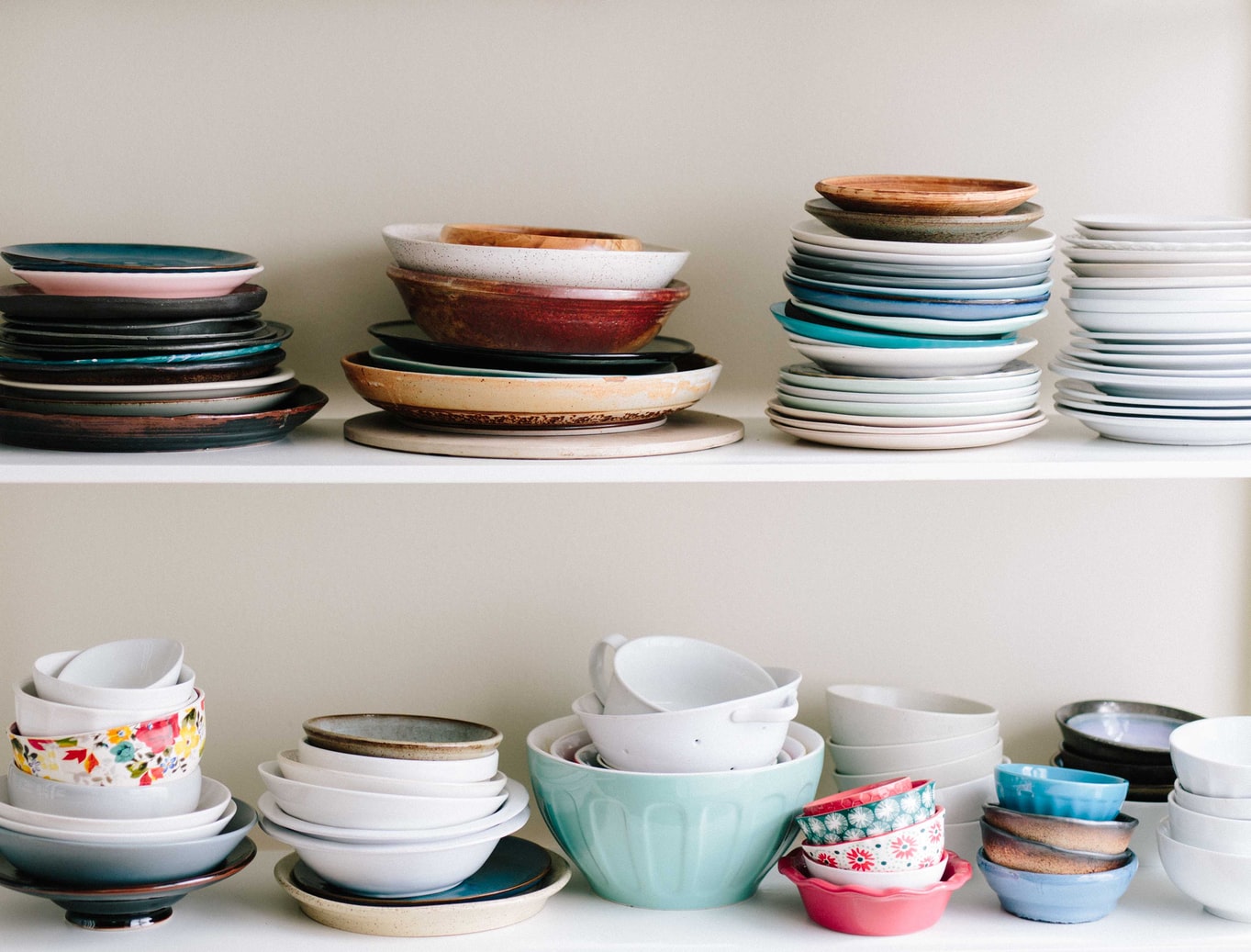Jump Ahead To:
Packing dishes for a long-distance move can be difficult. There are some steps that you can take to make the process easier and help prevent damage to your dishes and fine china. In this article, you will have all of the information needed to pack your dishes in such a way that they don’t break during your long-distance trip.

Materials you need to pack dishes
When packing, there tend to be spaces between dishes. While extra space can be nice at times, you want as little wiggle-room for your fragile dishes like glassware and fine china because it won’t do much to protect them from breaking if they get bumped or banged up during transit, or while in the truck or your car/van. Packing paper will provide a protective cushion that’s more effective than other materials in rounding out your dish-packing supplies list. Likewise, you’ll also need plenty of boxes – preferably with lids so that all those breakables are securely enclosed at one end while open on top to make loading easier when the time comes for unpacking too.
To pack your valuable dishes safely for a long-distance, you’ll need the following materials:
- Packing/wrapping paper: This piece of wrapper is handy for all types of dishware and pottery, and the rule of thumb when it comes to wrapping is – the more, the better. You can replace it with a newspaper, crumpled paper, or additional paper, but it’s risky for your plates and bowls because of possible newspaper ink transfers. You can also make use of bubble wrap or other sleeves made of another cushioning material.
- Dish boxes/glass pack boxes: Special boxes take the worry out of your breakables. These unique packages are designed with thicker and more durable materials – which protect fragile items from getting damaged in transit, as well as absorbing shocks so that accidents don’t happen at all. With the extra padding item to keep things safe inside, these special containers will make sure you have a happy homecoming no matter how far away it happens.
- Packing tape: A poor quality piece of tape dispenser will only cause frustration in the long run. You don’t want to end up having your boxes fall apart as you’re trying to seal them shut, or spend a lot of time taping and re-taping because the adhesive doesn’t work right away. Get yourself proper materials for better results.
Other packing materials you’ll need include:
- Medium-sized boxes
- Labels and markers
When calculating how many moving boxes you need, add on some dish boxes. To avoid breakage, they are more sturdy and thicker than typical boxes. The extra padding absorbs shock, making for a more stable carton. A dish box item provides better protection if an accident happens.
General steps to packing dishes for a long-distance trip
Packing dishes and fine china can be a time-consuming task since they are some of the trickiest items to pack, but following these five steps will make the process much easier:
1. Assemble each box and tape them well. The boxes may get heavy so be sure to use enough tape that the box won’t cave under the weight of your dishes. This first step is one of the very important preparatory steps in protecting your items.
2. Line each box with crumpled up paper to create a six-inch cushion at the bottom. Be sure to scrunch it all up, and not just fold or bend your pieces of paper as this is what will protect you best from any spills that occur while transporting them.
3.Layout your packing paper on a flat surface. Then, the next step is to place the dish in question right down next to it. Wrap up and secure with scotch tape as per need before putting it away for safekeeping until you’re ready to use again.
4.The key to packing dishes properly is in the order you pack them. Always start with the heaviest items, like plates and bowls, so that they take up more space at the bottom of your moving boxes than lighter pieces such as glasses.
5. For the fifth step: After you wrap your dishes and pack them in the box, make sure to ball up some paper at the top of the box as padding. Tape it shut and label it with what room it’s going into, which way is right side up (upside down), how fragile they are inside if any or not there’s a lot of weight so that no one throws it around by accident.
Remember not to pack the dish boxes till when they become heavier items. Be conscious of how much you’re loading into each box and try to keep each one under 45 pounds.
How to pack bowls and plates
Bowls in bundles and plates have the same method of packing. There are no handles or protrusions on these dishes, making them excellent for learning to pack dishes. It is essential to put heavy dishes in the boxes first. Bowls and plates can be packed individually or in bundles. Individual dishes are recommended, so stack only one at a time. It can save you some plates, especially the dinner plates and regular flat plates. Handling expensive dishes takes time. Use extra effort when deciding how to pack your dishes.
First, layout your packing paper or newspaper on a flat surface and then place the dish in the middle. Move the paper one corner at a time to meet in the middle. Next, place each dish in the box in the vertical position, as though you are loading a dishwasher. Repeat for each dish until your box is full. For lighter dishes, start another box once the first layer is complete.
How to pack cups, mugs, and glasses
You can pack mugs and cups the same way you would small bowls. However, Stemmed glasses are typically more durable than packed paper. Start by filling your cups, mugs, and glasses with crumpled packing paper. You can use one layer of paper or two sheets to wrap glasses and other breakable items. Spread out the packing paper on one corner of the dish.
Roll the dish to the opposite corner. Additionally, fold in the excess paper for additional protection of the breakable dishes, or use a bubble wrap. Feel free to bundle two of your dishes in one sheet of clean paper. To advance, place the next dish next to the first one and keep rolling to the end of the paper. To get the best results, your favorite mug and beer stein must be the same shape and material.
How to pack stemware
This is your most delicate dishes. You must know how to pack these dishes before you start the whole packing process. Use packing paper to form a paper padding, packing the bowl before adding packing tape to secure it. Then tilt the glass into a corner of your packing paper. As you roll the glass to the opposite corner of the overlapped paper, crumple the paper as you go.
For large packing paper, wrap two glasses in one sheet. When the first glass is wrapped in half a sheet of paper, lay the second glass next to it. Once the paper is fully wrapped, roll and fold again. Check that you can’t feel the edges of your glass on the sheets of paper. If you can, wrap the glass(es) in more wadded-up packing paper.
How to pack other kitchen items
For wrapping large objects such as pitchers, apply paper to the handles first. The teapot must be wrapped in rolled-up paper, then some more paper around the spout. To place the teapot upside down on the bottom of a stack of packing paper, fold a few sheets over it, and tape it in place. Separate the lid from the pot, and place both in the same box (the teapot should remain upside down in the box).
Package knives individually in paper, then bubble wrap. (Or wrap them in protective sleeves made for knives.) Label the bundles so you’re aware of sharp edges when you unpack. Nest packs of the graduated pot and pan sizes. Set up a small pan inside a larger pan and line the smaller pan with more packaging paper. Insert smaller pans and so on. Wrap nested pans with at least three more sheets of packing paper. before packaging it, seal the bundle with a piece of tape
Fill your packing box to the top
Wrap each bundle until you are three inches from the top of the carton. Also use crumpled layers of paper on the top, as well as small non-breakable items such as lightweight wooden or durable plastic trays. So that when you tape down the top flaps, you cannot press down on the top of the packaging box. If your carton is not well-packed, the resulting compression could damage your contents.
Mark all your boxes to make unpacking easier for the movers. Soon, you can flatten all of your dish barrels and packing boxes, as well as straighten and arrange all of your packing paper. Store packaging materials in a dry place. If you expect to be moving again soon, you should re-use your packing materials to help save on costs.
Here are some cities popular cities that we move to:
- Affordable Long Haul Movers to Dallas, Texas
- Affordable Long Haul Movers to Atlanta, Georgia
- Affordable Long Haul Movers to Chicago, Illinois
- Affordable Long Haul Movers to Portland, Oregon
- Affordable Long Haul Movers to Phoenix, Arizona
- Affordable Long Haul Movers to Austin, Texas
- Affordable Long Haul Movers to Baltimore, Maryland
- Affordable Long Haul Movers to Washington, DC
- Affordable Long Haul Movers to Nashville, Tennessee
- Affordable Long Haul Movers to Charlotte, North Carolina
- Affordable Long Haul Movers to Los Angeles, California
- Affordable Long Haul Movers to Houston, Texas
- Affordable Long Haul Movers to Indianapolis, Indiana
- Affordable Long Haul Movers to Seattle, Washington
- Affordable Long Haul Movers to Chattanooga, Tennessee
Other Long-Distance Moving Guides
Long-distance moves are undeniably tricky. We’ve put together a few guides to help you manage some of the thornier points of a long-distance move. And of course, if you need help with your long-distance move, just give us a call.
- Tips to prepare for a long-distance move
- Moving long-distance with a piano
- Cheapest way to move furniture long-distance
- Moving long-distance with kids
- Moving a refrigerator long-distance
- Moving long-distance with a dog
- How to move saltwater/freshwater fish
- How to pack pots & pans for a long-distance move
- How to move long-distance with a cat
- The 5 Best Neighborhoods in Saint Louis (Updated 2024) - March 15, 2024
- Is Moving to Pennsylvania Right for You? A 2024 Guide. - March 4, 2024
- The Best Neighborhoods in Cleveland (Updated 2024) - February 15, 2024



